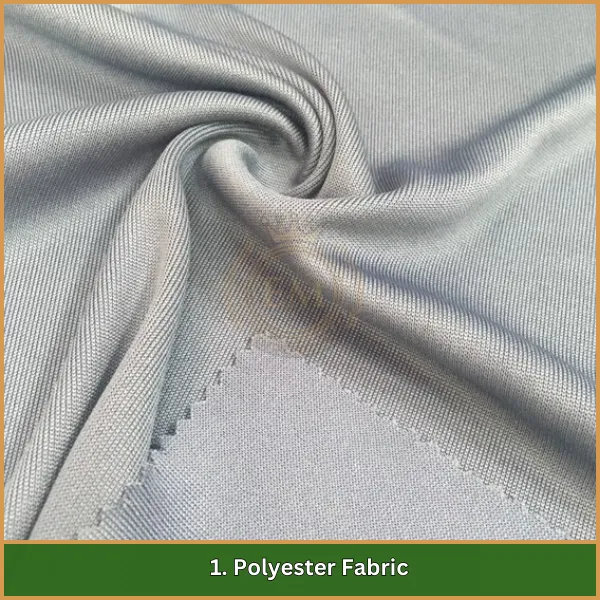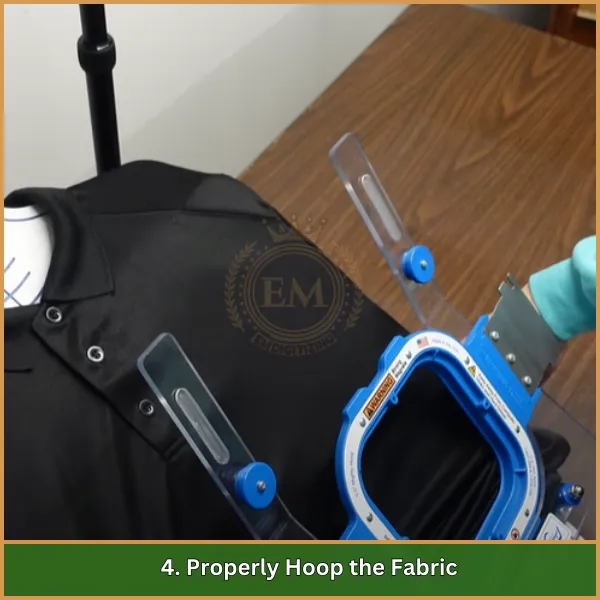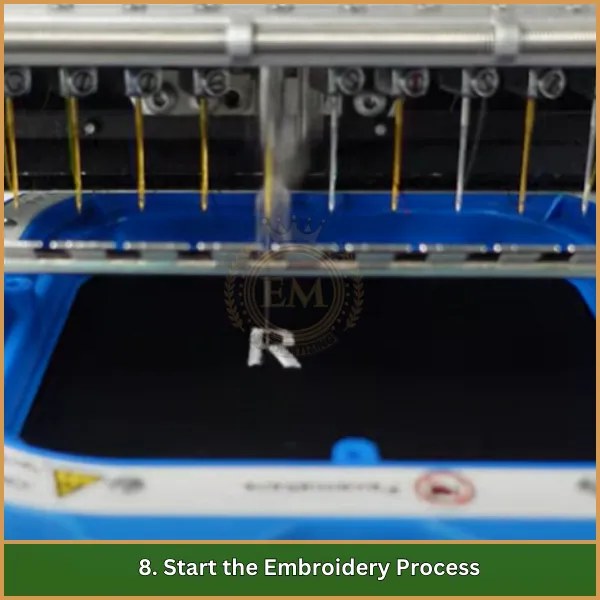Avez-vous déjà eu du mal avec la broderie sur du tissu polyester? Ce n’est un secret pour personne : le polyester peut être délicat : il est glissant, extensible, et a besoin d'un peu plus de soins. Mais ne laisse pas ça t'arrêter! Avec les bons outils et méthodes, vous pouvez obtenir des résultats étonnants.
Le polyester est un tissu incontournable pour les vêtements de sport, uniformes, et des accessoires stylés. Sa durabilité est inégalée, mais quand il s'agit de broderie, vous devrez utiliser le bon stabilisateur, aiguille, et du fil pour éviter les problèmes comme les plis ou les coutures inégales.
Dans ce guide, nous vous montrerons des conseils et des techniques simples pour manipuler le polyester en toute confiance. Que vous soyez débutant ou confirmé, ces étapes vous aideront à créer des designs qui ont l'air professionnels et qui durent longtemps. Prêt à commencer? Plongeons dedans!

Broderie sur tissu polyester | Guide étape par étape
Matériaux essentiels pour une broderie parfaite en polyester
La broderie sur tissu polyester peut être une expérience enrichissante si vous disposez des bons matériaux. Chaque outil et accessoire joue un rôle clé pour garantir la netteté de vos créations., professionnel, et durable. Voici tout ce dont vous avez besoin pour réussir votre broderie polyester.
- Tissu en polyester
- Fil à broder en polyester
- Machine à broder
- Cercles à broder (de préférence en plastique)
- Stabilisateur (déchirable ou découpé)
- Marqueur de tissu ou craie
- Ciseaux ou cisailles
- Stabilisateur de garniture (optionnel, pour certains modèles)
1. Tissu en polyester

Le polyester est un matériau polyvalent, tissu résistant, parfait pour la broderie. Sa surface lisse et sa résistance à l'usure le rendent idéal pour les conceptions complexes et simples. Cependant, il y a quelques défis: il s'étire facilement et est sensible à la chaleur. L’utilisation de stabilisateurs et de réglages de chaleur faible peut aider à éviter ces problèmes.
2. Fil à broder en polyester
Le fil pour la broderie sur tissu en polyester change la donne. Il offre des couleurs vibrantes, excellente durabilité, et résistance à la décoloration, même après des lavages fréquents. Ce fil correspond à la résistance et à la flexibilité du tissu, garantissant que votre broderie reste intacte.
3. Machine à broder
Une machine à broder efficace est votre meilleure alliée pour travailler le polyester. Choisissez une machine avec des contrôles de tension précis et des conceptions programmables pour gérer la texture glissante du polyester et fournir des résultats cohérents.
4. Cercles à broder (De préférence en plastique)
Les cerceaux en plastique adhèrent mieux au tissu en polyester que ceux en bois. Ils empêchent le glissement et aident à maintenir le tissu tendu, garantissant que votre broderie ressorte lisse et uniformément cousue.
5. Stabilisateur (Détachable ou découpé)
Les stabilisateurs sont essentiels pour gérer l’étirement du polyester. Un entoilage déchirable est idéal pour la broderie légère, tandis qu'un stabilisateur découpé offre un support supplémentaire pour les conceptions denses ou détaillées..
6. Marqueur de tissu ou craie
Un placement précis est la clé d'une broderie impeccable. Les marqueurs de tissu ou la craie vous aident à marquer la zone de motif sans laisser de taches permanentes, assurer que votre broderie est parfaitement alignée.
7. Ciseaux ou cisailles
Les bords nets comptent! Des ciseaux ou cisailles de haute qualité vous permettent de couper proprement l'excédent de fil et d'entoilage, donner à votre projet une finition professionnelle.
8. Stabilisateur de garniture (Facultatif)
Pour les tissus en polyester texturés ou extensibles, un stabilisateur de garniture est un excellent ajout. Il empêche les points de s'enfoncer dans le tissu, ce qui est particulièrement utile pour les conceptions audacieuses ou détaillées.
Processus de broderie machine sur tissu polyester
Broderie en tissu polyester peut donner des résultats époustouflants si on l’aborde avec les bons outils et techniques. Voici comment démarrer et assurer le succès.
1. Préparez le tissu

Lavez le tissu en polyester avec un détergent doux et de l'eau froide pour éliminer toute saleté ou résidu qui pourrait gêner la broderie.. Repassez-le légèrement à basse température pour lisser les rides., assurer une propreté, surface plane pour coudre. Évitez la chaleur élevée pour éviter d'endommager le tissu.
2. Sélectionnez et numérisez votre conception

Choisissez un motif qui correspond à votre projet et numérisez-le à l'aide d'un logiciel de broderie. Ajustez la densité et les types de points en fonction de la nature glissante du polyester. Si la numérisation semble difficile, EMnumérisation propose des services professionnels pour convertir vos illustrations en fichiers de broderie de haute qualité, garantir des résultats parfaits à chaque fois.
3. Choisissez les couleurs de fil parfaites

Choisissez le polyester fils à broder qui complètent ou contrastent avec votre tissu. Ces fils sont durables, vibrant, et conçu pour supporter des lavages fréquents. Utilisez les codes de fil appropriés pour obtenir une correspondance précise des couleurs.
4. Encercler correctement le tissu

Poser un stabilisateur (déchirable ou découpé) sur le cerceau inférieur. Placez le tissu en polyester dessus, s'assurant qu'il est lisse et sans rides. Fixez le tissu en attachant le cerceau supérieur, en le gardant tendu mais pas trop étiré pour éviter les plis.
5. Marquer l'emplacement de conception

Utilisez un marqueur pour tissu soluble dans l'eau ou une craie de tailleur pour marquer le centre et les points d'alignement de votre motif.. Cela aide à positionner la broderie avec précision.
6. Préparez votre machine à broder

Le client est très content, procédures de contrôle renforcées. En tant que promoteur immobilier, peines, ni l'ullamcorper de la propriété, oreiller protéiné.
7. Ajuster les paramètres de la machine

Réglez la vitesse de la machine à un niveau modéré, entre 500 et 800 points par minute, pour manipuler efficacement le tissu en polyester. Ajustez la longueur du point en fonction de la complexité du motif, avec des points plus courts pour les zones plus denses et des points plus longs pour la texture.
8. Démarrer le processus de broderie

Commencez à coudre tout en surveillant de près les progrès. Gardez un œil sur les fils cassés ou les plis du tissu.. Arrêtez la machine si nécessaire pour effectuer des réglages de tension ou d'alignement..
9. Surveiller les progrès et effectuer des ajustements

Mettez la machine en pause de temps en temps pour inspecter la broderie. Assurez-vous que les points sont cohérents, et ajustez les paramètres du cerceau ou de la tension si nécessaire pour maintenir la précision.
10. Terminez la broderie

Une fois la broderie terminée, retirez soigneusement le cerceau de la machine. Coupez les fils lâches et retirez l'entoilage sans tirer sur le tissu.. Si vous avez utilisé un stabilisateur de garniture, arrachez-le doucement du motif.
11. Prendre soin de la pièce finie

Lavez délicatement le tissu brodé pour éliminer les lignes de craie ou de marqueur. Si besoin, repassez-le légèrement à basse température pour lisser les rides et lui donner un aspect soigné.
Conseils pour réussir sa broderie sur polyester
Réaliser une broderie impeccable sur du tissu polyester demande de la précision, les bons outils, et des techniques réfléchies. Voici quelques conseils pratiques pour vous aider à créer de superbes designs.
- Optez pour des aiguilles à bille: Des aiguilles à bout arrondi comme des aiguilles à bille ou des aiguilles extensibles glissent entre les fibres, réduisant les points sautés et évitant d'endommager le tissu.
- Choisissez des fils correspondants: Utilisez des fils à broder en polyester ou en rayonne pour leur souplesse et leur brillance. Ces fils complètent mieux le tissu en polyester que le coton, qui manque d'élasticité.
- Ajustez les paramètres de votre machine: Ajustez votre machine à broder pour réduire la densité des points et resserrez légèrement la tension.. Garder une vitesse modérée (autour 500-800 points par minute) minimise les déplacements pendant la couture.
- Numérisez intelligemment: Planifiez votre conception en pensant au polyester. Numérisez les motifs pour coudre vers l'extérieur à partir du centre afin de minimiser l'étirement et la distorsion..
- Utilisez un adhésif pour plus de stabilité: Une légère pulvérisation d'adhésif temporaire sur l'entoilage aide à fixer le tissu et à le maintenir en place pendant la couture..
- Gardez les conceptions simples: Évitez les designs trop denses, car ils peuvent conduire à des plissements. Optez pour des contours épurés et des remplissages moins complexes pour de meilleurs résultats.
- Testez avant de coudre: Testez toujours vos réglages sur un morceau de tissu en polyester pour éviter des erreurs coûteuses sur votre pièce finale.
Conclusion
Faire de la broderie sur du tissu polyester peut être simple si vous utilisez les bons outils et suivez les bonnes étapes. Avec de bons stabilisateurs, aiguilles, et des techniques appropriées, vous pouvez rendre vos créations incroyables. Le polyester peut sembler délicat au début, mais avec la bonne approche, ça devient beaucoup plus facile.
Si vous voulez des designs parfaits sans tracas, essayez EMDigitizing! Nous proposons des prix abordables services de numérisation avec un délai d'exécution ultra-rapide et une qualité garantie. Plus, vous pouvez voir un aperçu gratuit de votre conception avant de la finaliser.
Êtes-vous un nouveau client? Vous obtiendrez une exclusivité 50% remise sur votre première commande! Ne manquez pas cette occasion de rendre vos projets de broderie plus faciles et meilleurs avec Numérisation EM.
Cliquez ici pour commencer!
FAQ
Absolument! Le tissu en polyester est idéal pour la broderie lorsqu'il est manipulé correctement. Avec le bon stabilisateur, aiguille, et fil, vous pouvez réaliser des designs magnifiques et durables sur ce tissu polyvalent.
Les modèles légers avec une densité de points inférieure sont idéaux pour le polyester. Ces types de conceptions réduisent le risque de froncement et garantissent que le tissu conserve sa forme tout au long du processus..
Oui, l'utilisation d'aiguilles à bille et de fils polyester est indispensable. Les aiguilles à bille glissent doucement à travers les fibres, et les fils en polyester assurent solidité et souplesse à votre broderie.
Oui, le polyester peut s'étirer, ce qui pourrait déformer votre conception. Pour éviter cela, évitez de trop serrer le tissu dans le cercle et utilisez un entoilage pour maintenir le tout en place.
